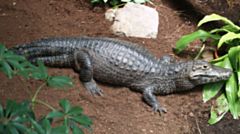Project 4856: J. P. Rio, P. D. Mannion. 2021. Phylogenetic analysis of a new morphological dataset elucidates the evolutionary history of Crocodylia and resolves the long-standing gharial problem. PeerJ. 9:e12094.
Abstract
First appearing in the latest Cretaceous, Crocodylia is a clade of semi-aquatic, predatory reptiles, defined by the last common ancestor of extant alligators, caimans, crocodiles, and gharials. Despite large strides in resolving crocodylian interrelationships over the last three decades, several outstanding problems persist in crocodylian systematics. Most notably, there has been persistent discordance between morphological and molecular datasets surrounding the affinities of the extant gharials, Gavialis gangeticus and Tomistoma schlegelii. Whereas molecular data consistently support a sister taxon relationship, in which they are more closely related to crocodylids than to alligatorids, morphological data indicate that Gavialis is the sister taxon to all other extant crocodylians. Here we present a new morphological dataset for Crocodylia based on a critical reappraisal of published crocodylian character data matrices and extensive firsthand observations of a global sample of crocodylians. This comprises the most taxonomically comprehensive crocodylian dataset to date (144 OTUs scored for 330 characters) and includes a new, illustrated character list with modifications to the construction and scoring of characters, and 46 novel characters. Under a maximum parsimony framework, our analyses robustly recover Gavialis as more closely related to Tomistoma than to other extant crocodylians for the first time based on morphology alone. This result is recovered regardless of the weighting strategy and treatment of quantitative characters. However, analyses using continuous characters and extended implied weighting (with high k-values) produced the most resolved, well-supported, and stratigraphically congruent topologies overall. Resolution of the gharial problem reveals that: (1) several gavialoids lack plesiomorphic features that formerly drew them towards the stem of Crocodylia; and (2) more widespread similarities occur between species traditionally divided into tomistomines and gavialoids, with these interpreted here as homology rather than homoplasy. There remains significant temporal incongruence regarding the inferred divergence timing of the extant gharials, indicating that several putative gavialids (‘thoracosaurs’) are incorrectly placed and require future re-appraisal. New alligatoroid interrelationships include: (1) support for a North American origin of Caimaninae in the latest Cretaceous; (2) the recovery of the early Paleogene South American taxon Eocaiman as a ‘basal’ alligatoroid; and (3) the paraphyly of the Cenozoic European taxon Diplocynodon. Among crocodyloids, notable results include modifications to the taxonomic content of Mekosuchinae, including biogeographic affinities of this clade with latest Cretaceous–early Paleogene Asian crocodyloids. In light of our new results, we provide a comprehensive review of the evolutionary and biogeographic history of Crocodylia, which included multiple instances of transoceanic and continental dispersal.Read the article »
Article DOI: 10.7717/peerj.12094
Project DOI: 10.7934/P4856, http://dx.doi.org/10.7934/P4856
| This project contains |
|---|
Download Project SDD File |
Currently Viewing:
MorphoBank Project 4856
MorphoBank Project 4856
- Creation Date:
28 August 2023 - Publication Date:
28 August 2023
Authors' Institutions ![]()
- Imperial College London
- University College London
Members
| member name | taxa |
specimens |
media |
| MorphoBank Curator Project Administrator | 1 | 1 | 1 |
Project has no matrices defined.
Project downloads 
| type | number of downloads | Individual items downloaded (where applicable) |
| Total downloads from project | 1 | |
| Document downloads | 1 | TNT file with continuous and discrete morphological characters (Analysis 1 and 3). (1 download); |

